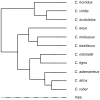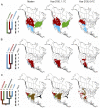Pleistocene climate, phylogeny, and climate envelope models: an integrative approach to better understand species' response to climate change
- PMID: 22164305
- PMCID: PMC3229599
- DOI: 10.1371/journal.pone.0028554
Pleistocene climate, phylogeny, and climate envelope models: an integrative approach to better understand species' response to climate change
Abstract
Mean annual temperature reported by the Intergovernmental Panel on Climate Change increases at least 1.1°C to 6.4°C over the next 90 years. In context, a change in climate of 6°C is approximately the difference between the mean annual temperature of the Last Glacial Maximum (LGM) and our current warm interglacial. Species have been responding to changing climate throughout Earth's history and their previous biological responses can inform our expectations for future climate change. Here we synthesize geological evidence in the form of stable oxygen isotopes, general circulation paleoclimate models, species' evolutionary relatedness, and species' geographic distributions. We use the stable oxygen isotope record to develop a series of temporally high-resolution paleoclimate reconstructions spanning the Middle Pleistocene to Recent, which we use to map ancestral climatic envelope reconstructions for North American rattlesnakes. A simple linear interpolation between current climate and a general circulation paleoclimate model of the LGM using stable oxygen isotope ratios provides good estimates of paleoclimate at other time periods. We use geologically informed rates of change derived from these reconstructions to predict magnitudes and rates of change in species' suitable habitat over the next century. Our approach to modeling the past suitable habitat of species is general and can be adopted by others. We use multiple lines of evidence of past climate (isotopes and climate models), phylogenetic topology (to correct the models for long-term changes in the suitable habitat of a species), and the fossil record, however sparse, to cross check the models. Our models indicate the annual rate of displacement in a clade of rattlesnakes over the next century will be 2 to 3 orders of magnitude greater (430-2,420 m/yr) than it has been on average for the past 320 ky (2.3 m/yr).
Conflict of interest statement
Figures








Similar articles
-
Phylogeography and ecological niche modeling unravel the evolutionary history of the Yarkand hare, Lepus yarkandensis (Mammalia: Leporidae), through the Quaternary.BMC Evol Biol. 2019 Jun 1;19(1):113. doi: 10.1186/s12862-019-1426-z. BMC Evol Biol. 2019. PMID: 31153378 Free PMC article.
-
Including Fossils in Phylogenetic Climate Reconstructions: A Deep Time Perspective on the Climatic Niche Evolution and Diversification of Spiny Lizards (Sceloporus).Am Nat. 2016 Aug;188(2):133-48. doi: 10.1086/687202. Epub 2016 Jun 8. Am Nat. 2016. PMID: 27420780
-
Thermal niches of planktonic foraminifera are static throughout glacial-interglacial climate change.Proc Natl Acad Sci U S A. 2021 May 4;118(18):e2017105118. doi: 10.1073/pnas.2017105118. Proc Natl Acad Sci U S A. 2021. PMID: 33903233 Free PMC article.
-
Cenozoic mean greenhouse gases and temperature changes with reference to the Anthropocene.Glob Chang Biol. 2016 Dec;22(12):3843-3858. doi: 10.1111/gcb.13342. Epub 2016 Jun 1. Glob Chang Biol. 2016. PMID: 27151305 Review.
-
Paleobotany and Global Change: Important Lessons for Species to Biomes from Vegetation Responses to Past Global Change.Annu Rev Plant Biol. 2018 Apr 29;69:761-787. doi: 10.1146/annurev-arplant-042817-040405. Annu Rev Plant Biol. 2018. PMID: 29719166 Review.
Cited by
-
Phylogeography and ecological niche modeling unravel the evolutionary history of the Yarkand hare, Lepus yarkandensis (Mammalia: Leporidae), through the Quaternary.BMC Evol Biol. 2019 Jun 1;19(1):113. doi: 10.1186/s12862-019-1426-z. BMC Evol Biol. 2019. PMID: 31153378 Free PMC article.
-
The impact of climate change on the burden of snakebite: Evidence synthesis and implications for primary healthcare.J Family Med Prim Care. 2022 Oct;11(10):6147-6158. doi: 10.4103/jfmpc.jfmpc_677_22. Epub 2022 Oct 31. J Family Med Prim Care. 2022. PMID: 36618235 Free PMC article.
-
Systematics and Phylogenetic Interrelationships of the Enigmatic Late Jurassic Shark Protospinax annectans Woodward, 1918 with Comments on the Shark-Ray Sister Group Relationship.Diversity (Basel). 2023 Feb 21;15(3):311. doi: 10.3390/d15030311. Diversity (Basel). 2023. PMID: 36950326 Free PMC article.
-
Montane diversification as a mechanism of speciation in neotropical butterflies.Ecol Evol. 2024 Jul 11;14(7):e11704. doi: 10.1002/ece3.11704. eCollection 2024 Jul. Ecol Evol. 2024. PMID: 39005883 Free PMC article.
-
The past as a lens for biodiversity conservation on a dynamically changing planet.Proc Natl Acad Sci U S A. 2023 Feb 14;120(7):e2201950120. doi: 10.1073/pnas.2201950120. Epub 2023 Feb 6. Proc Natl Acad Sci U S A. 2023. PMID: 36745815 Free PMC article. No abstract available.
References
-
- Solomon S, Qin D, Manning M, Chen Z, Marquis M, et al. Cambridge, UK: 2007. IPCC. Climate Change 2007:The Physical Science Basis. Contribution of Working Group I to the Fourth Assessment Report of the Intergovernmental Panel on Climate Change.
-
- Petit JR, Jouzel J, Raynaud D, Barkov NI, Barnola J-M, et al. Climate and atmospheric history of the past 420,000 years from the Vostok ice core, Antarctica. Nature. 1999;399:429–436.
-
- Thomas CD, Cameron A, Green RE, Bakkenes M, Beaumont LJ, et al. Extinction risk from climate change. Nature. 2004;427:145–148. - PubMed
-
- Moritz C, Patton JL, Conroy CJ, Parra JL, White GC, et al. Impact of a Century of Climate Change on Small-Mammal Communities in Yosemite National Park, USA. Science. 2008;322:261–264. - PubMed
Publication types
MeSH terms
Substances
LinkOut - more resources
Full Text Sources
Medical
Miscellaneous

